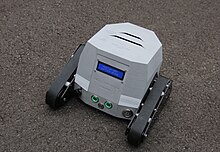Surface drone
Surface drone is a series of civilly used measuring robots from the manufacturer Müller-BBM .
commitment
The robots allow various physical properties of road surfaces to be measured automatically and the measurement data obtained to be evaluated. To do this, the robots record different sizes with different sensors while driving over the surface. In particular, the robots determine the surface roughness and the longitudinal evenness, two relevant characteristics of road surfaces. The measurement and evaluation of the surface roughness, which is relevant with regard to tire-road noise , rolling resistance and wet grip, is carried out in accordance with ISO 13473-1, among other things. The robots can be used for new paving of road surfaces (for quality assurance) as well as in operation (to detect changes caused by traffic). The robots are mainly used by building material testing laboratories and larger construction companies as well as by tire and vehicle manufacturers. For the latter, the properties of the road surfaces on test tracks are of particular interest. According to the manufacturer, measuring the longitudinal evenness with the robot has so far only been of orientation and can be used to measure the standard, e.g. B. do not replace with the planograph . Other roughness measuring systems measure either point-wise or stationary or are mounted on carrier vehicles, mostly cars. In comparison, the surface drone systems are easier to use, so that they can also be used by laypeople and are ready for use more quickly.
technology
In the versions currently in use, the small robot weighs around 4 kg and travels at around 1 km / h. The chassis of the robots is designed with rubber chain-like belts. Due to the special belt drive, the contact area to the road is to be enlarged compared to a chassis with wheels in order to minimize the influence of the surface roughness on the height accuracy of the robot. The belts do not have any segments and are designed with a smooth outer surface - this should also contribute to the smoothest possible, low-vibration driving condition. The sensors ( laser triangulation sensor for roughness measurement, inclination sensor, GNSS sensor and optional surface temperature sensor) are housed in a housing that is manufactured using selective laser sintering . The movement is controlled by remote control. An accumulator is permanently installed as an energy source with which approx. 3 hours of continuous measurement operation are possible.
Web links
Individual evidence
- ↑ https://www.strabag.com/databases/internet/_public/content.nsf/web/A932C2A86080C162C1258472004C3516
- ↑ https://www.mplusp.eu/flashm
- ↑ http://www.euronoise2018.eu/docs/papers/452_Euronoise2018.pdf
- ↑ https://3druck.com/case-studies/3d-gedrucktes-gehaeuse-und-fuehrungsrolle-fuer-die-surface-drone-der-mueller-bbm-5453700/
